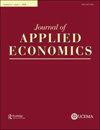优化政策以实现农业转型目标:埃塞俄比亚的应用
IF 1.4
4区 经济学
Q3 ECONOMICS
引用次数: 2
摘要
决策者在预算限制下寻求可能相互冲突的目标。解决这一问题需要一种多准则决策技术,其中动态可计算一般均衡模型的方程是策略优化问题的约束。我们在农业转型目标的框架中说明了这种方法。利用埃塞俄比亚的数据,我们展示了政策目标与如何以最佳方式确定政策以达成最佳妥协之间的潜在冲突。例如,如果埃塞俄比亚的政策制定者追求增加农业食品GDP、农村家庭福利或农业食品出口,他们不一定会观察到这些目标之间的强烈权衡。然而,如果他们投资于不同的农业部门以实现这些目标,他们为投资提供资金的方式将导致宏观经济的权衡。只有当新的投资大部分分配给油籽和咖啡时,这三个政策目标不仅会同时得到改善,而且会得到最大程度的改善。本文章由计算机程序翻译,如有差异,请以英文原文为准。
Optimising policies to achieve agricultural transformation objectives: an application for Ethiopia
ABSTRACT Policymakers seek objectives that can be conflicting under a budget constraint. Solving this problem requires a multi-criteria decision-making technique whereby equations of a dynamic computable general equilibrium model are constraints to a policy optimisation problem. We illustrate this approach in the framework of agricultural transformation objectives. Using data for Ethiopia we show the potential conflict between policy objectives and how policies are optimally determined to arrive at the best possible compromise. Should Ethiopian policymakers pursue increasing agri-food GDP, rural household welfare, or agri-food exports, for example, they will not necessarily observe strong trade-offs between these objectives. However, if they invest in different agricultural sectors to achieve such objectives, the way in which they finance the investment will result in macroeconomic trade-offs. Only when the new investment is mostly allocated to oilseeds and coffee will there be not only simultaneous but also maximised improvement in all three policy objectives.
求助全文
通过发布文献求助,成功后即可免费获取论文全文。
去求助
来源期刊

Journal of Applied Economics
ECONOMICS-
CiteScore
3.00
自引率
0.00%
发文量
57
审稿时长
40 weeks
期刊介绍:
The Journal of Applied Economics publishes papers which make a significant and original contribution to applied issues in micro and macroeconomics. The primary criteria for selecting papers are quality and importance for the field. Papers based on a meaningful and well-motivated research problem that make a concrete contribution to empirical economics or applied theory, in any of its fields, are especially encouraged. The wide variety of topics that are covered in the Journal of Applied Economics include: -Industrial Organization -International Economics -Labour Economics -Finance -Money and Banking -Growth -Public Finance -Political Economy -Law and Economics -Environmental Economics
 求助内容:
求助内容: 应助结果提醒方式:
应助结果提醒方式:


